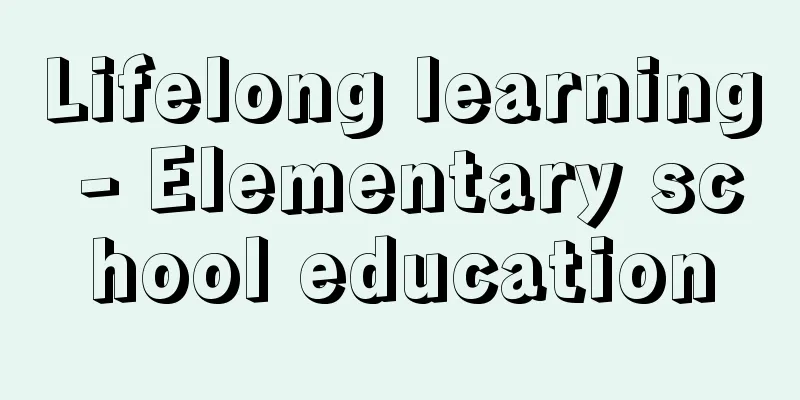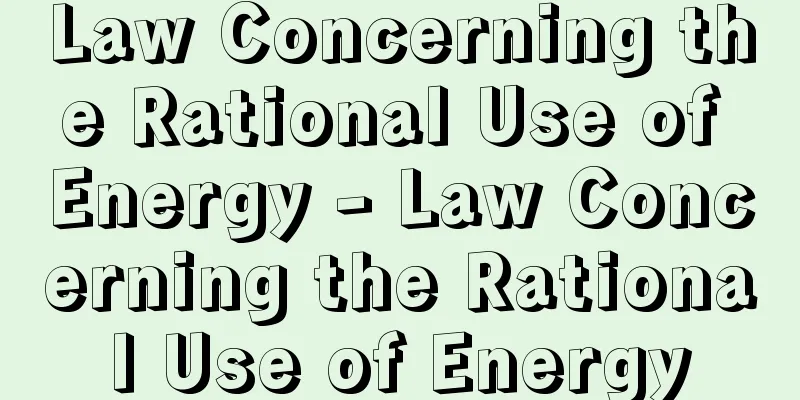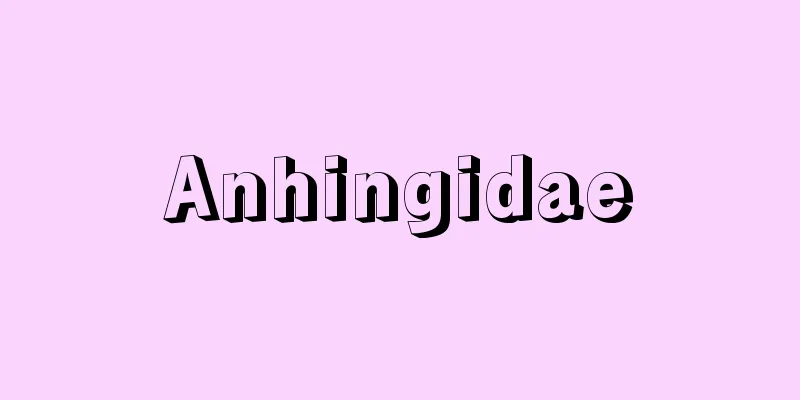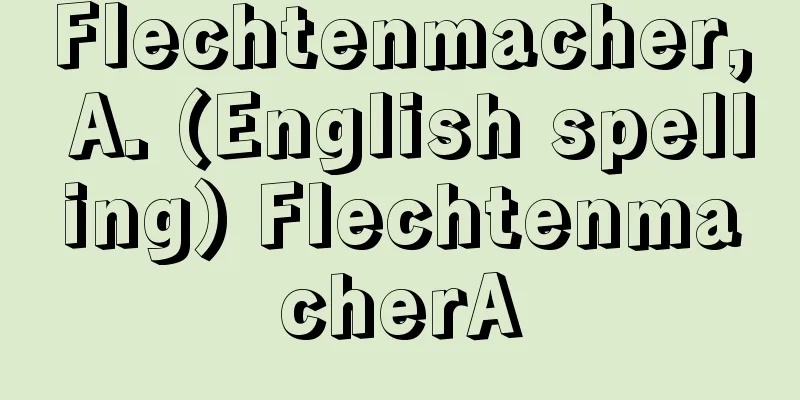Lifelong learning - Elementary school education

|
It refers to the overall function of the educational structure (the comprehensive organization of systems, administration, finances, educational content, etc.) that supports people's lifelong learning. It has been widely used in Japan since the 1970s as a translation of "lifelong education." Examples of this English usage can be seen before World War II, but it became popular in many countries after UNESCO (United Nations Educational, Scientific and Cultural Organization) began to define the meaning of the word from a new angle in the perspective of international education administration. In contrast, lifelong learning refers to learning activities that people continue independently throughout their lives. [Hideo Fujiwara] Establishment of the philosophyIt all started with a memorandum distributed in advance at the end of 1965 by Paul Lengrand of France, head of the Division of Continuing Education (abolished in 1969), for a meeting of the International Committee for the Promotion of Adult Education, an advisory body to the Director-General of UNESCO. The gist of the memorandum was that "the educational care provided by national society to support the lifelong learning process of each citizen must be integrated and coordinated as a whole, including both formal and informal education, so that the educational process can be adapted to each individual learner. To achieve this, adult education needs to become something that leads to changes in the entire educational structure. Let us consider the promotion of adult education from this perspective." In the great debate that unfolded in Europe after the conference, Frank Jessup, a member of the committee at Oxford University in the UK, emphasized the need to enrich the entire educational process through "vertical integration" of educational considerations that help individuals learn throughout their lives, in line with the individual development of the learner, and "horizontal integration" that matches the current state of development. The word "lifelong" used at that time attracted attention among UNESCO-related commentators, and the term "lifelong (integrated) education" appeared frequently in UNESCO official documents the following year, 1966, and this idea was adopted at the General Assembly that year. Thus, the principle of integrated lifelong education was advocated as the guiding principle for the review of the education system and the reorganization of the education structure in each member state (the word "integrated" was soon dropped as being self-evident, and later "idea" came to be used instead of "principle"). Vertical integration is achieved through adjustments along the axis of time, including issues such as articulation between educational institutions that correspond to each person's developmental process, and expanding freedom of admission and withdrawal and use at any time. Horizontal integration is achieved through cross-sectional adjustments, such as cooperation and collaboration between secondary schools and out-of-school youth education institutions that support each person's learning in parallel, and even the shift between curricula and programs. This kind of multifaceted, constant adjustment, which sometimes even includes system reform, will realize an education structure that can better support each person's lifelong learning. One basic reference material that supports these ideals is the Faure Report of UNESCO's International Commission on the Development of Education (published in French in 1972 under the title " apprendre à être ", which can be translated as "learning to live"; the English version was subsequently published as " Learning To Be "). [Hideo Fujiwara] Relationship with school educationThe idea of lifelong education does not ignore school system reform, but rather emphasizes it. However, as early as 1971, Belgian sociologist Henri Janne and others assumed that school reorganization would meet with stubborn resistance in any country, and that in many cases it would be necessary to begin with new developments involving adjustments in out-of-school education (what is called social education in Japan). They reported on examples of practice in Belgium and the development of an integrated adult education system that transcends administrative affiliations and labor-management conflicts. There are many movements along these lines in developed countries. In any case, it was groundbreaking that the idea of making the entire educational structure better adjusted for the people living today and tomorrow was presented in the name of lifelong education. The Council of Europe, which is made up of around 20 countries, worked with UNESCO to establish the concept of lifelong education. Its secretariat is based in Strasbourg, France, and published L'Éducation Permanente (French for "permanent education"; English: Permanent Education ) in 1970, written by 15 leading commentators. Along with several chapters on extracurricular education, the book also contains chapters on topics such as "preschool education in Europe," "reorganization of school education," "recurrent education," and "the impact of new ideas in extracurricular education on schools." All of these discussions also underpinned the concept of lifelong education. [Hideo Fujiwara] Impact on countriesEach country has a different way of accepting this concept, and it is said that the first country to fully accept it was the former Yugoslavia. In France, where UNESCO is based, they had already been working on major reforms of the school system since the 1960s, and it can be said that they accepted it in the way that national universities were obligated to carry out university open-door activities during the last university reform. Since the establishment of the Fifth Republic through constitutional reform in 1958, France has made a national effort to foster extracurricular education, especially youth activities, and from the beginning, the term l'éducation permanente was used to encompass both "adult education" and "out-of-school youth education." As UNESCO moved to expand l'éducation permanente to include lifelong education, the term became ambiguous. However, since the educational reform had reached a stage, it can be said that they tried to achieve the results of lifelong education by focusing on the enhancement and development of extracurricular education. The UK is the most advanced country in adult education and out-of-school youth education, and reaching that level was even a challenge for Germany, France, and other countries after World War II. Moreover, with a history of prioritizing private schools in the entire school system, including universities, and NGOs (non-governmental organizations) in out-of-school education, it can be said to have provided a model of thinking about lifelong education led by the private sector. Since the 1970s, the promotion of youth activities that go beyond the administrative system has been remarkable. In the Nordic countries, adult education, including university opening (university expansion), is as advanced as in the UK. In these countries, the claim of recurrent education, which aims to reorganize school structures to allow adults to re-enroll in school or re-re ... In the United States, the primary and secondary school system is thoroughly decentralized, and for a long time, school boards, which are equivalent to Japan's Board of Education, had little to do with lifelong education when it comes to out-of-school education. As discussions of lifelong education intensified, the education authority, which was a bureau of the Department of Social Security in the United States, was upgraded to a ministry. There has also been a rapid increase in community colleges in each state, and a clear tendency toward school reform. In the United States, the term "lifelong learning" tends to be used instead of "lifelong education." [Hideo Fujiwara] Development of the theory of lifelong educationThe development of lifelong education theory in Japan has been unique, and with the exception of the "systematization" theories of some experts, the issue of school structure has long been shelved, with many discussions emphasizing the need to develop new areas of social education. This too can be said to have positive significance, insofar as it encompasses a wide range of educational projects, including those under the jurisdiction of administrative departments other than the Ministry of Education, Culture, Sports, Science and Technology and the Board of Education, and is a movement to envision a broader view of social education. This movement has been attempted in the name of lifelong education, under the initiative of the heads of several local governments, including Akita Prefecture and Hyogo Prefecture. Akita Prefecture's efforts in this field began in 1970 with the establishment of a project team consisting of the prefectural governor's office (Governor Obata Yujiro at the time) and 16 members of the Board of Education. In 1971, the field was included as a major issue in the prefecture's Third Comprehensive Development Plan, and since then, it has been positioned as a pillar of prefectural government. In 1972, the "Lifelong Education Promotion Headquarters" was created, integrating the prefectural governor's office and the Board of Education, with the governor as the head and the vice governor and superintendent of education as deputy heads. The "Lifelong Education Promotion Council" was established as an advisory body, and was made the parent organization for understanding the wishes of the prefecture's citizens regarding lifelong education and promoting its spread. In 1973, the "Lifelong Education Instructors Group" was reorganized into the "Education Human Resources Bank," and by 1985, 31 cities, towns, and villages in the prefecture had their own education human resources banks. On a regional level, universities for working adults (community colleges) were opened in three locations: the prefectural lifelong education center in the center, the north, and the south. Moreover, most cities, towns, and villages have established comprehensive lifelong education promotion systems that integrate general administration and education administration, and the number of study groups exceeds 10,000. Steady progress has been made through local initiatives. In Hyogo Prefecture, not only was a lifelong education forum established to respond to inquiries from the governor, but a large part of the social education-related affairs under the jurisdiction of the Prefectural Board of Education was transferred to the prefectural governor's office and included in the affairs for promoting cultural activities. As a result, learning activities for out-of-school youth and the elderly are being actively carried out in a more integrated manner with strong financial backing. Both prefectures can be said to have shown examples of coordination between administrative departments in line with the lifelong education philosophy. In Japan, too, the movement for educational reform has finally become the focus of public attention, policy movements have become active, and following the final report of the Provisional Education Council (Rinkyo-in), the government has indicated its direction for implementing organizational reforms at the Ministry of Education. In 1988 (Showa 63), the Ministry of Education reorganized the Social Education Bureau and established the Lifelong Learning Bureau. In 1990 (Heisei 2), the first legal system regarding lifelong learning, the "Law Concerning the Promotion System of Measures for the Promotion of Lifelong Learning" (commonly known as the Lifelong Learning Promotion Law), came into effect. Furthermore, lifelong learning councils were established in each prefecture, separate from the council of the same name within the Ministry of Education, and local lifelong learning promotion subsidies were disbursed to prefectures and municipalities. In 1998, the Women's Education Division of the Lifelong Learning Bureau of the Ministry of Education was reorganized as the Gender Equality Learning Division, and systems for promoting lifelong learning were established in each local government. In 2001, the Ministry of Education and the Science and Technology Agency were merged to form the Ministry of Education, Culture, Sports, Science and Technology, and the Lifelong Learning Bureau was reorganized as the Lifelong Learning Policy Bureau. At first glance, UNESCO's lifelong education promotion activities since the late 1970s seem to be focused entirely on "out-of-school education," but this does not necessarily mean that the basic philosophy has changed. Reflecting on the failure of the hasty expansion of schools in developing countries, UNESCO has begun to seek ways to develop education through out-of-school literacy activities, and has expanded its humanitarian-motivated activities, such as providing a place of learning through non-formal education (out-of-school education) to those in developing countries who cannot enjoy school education. Ettore Gelpi, who became UNESCO's lifelong education promotion officer in 1972, often speaks about out-of-school education, but he himself is based on the idea of lifelong education, which also includes school education, as can be seen from his statement that "all educational structures for children, adolescents and adults, whether in or out of school, are being questioned by lifelong education policies." Furthermore, even if his proposals for concrete measures, which were based on his focus on "oppression and liberation," appear to be biased toward the scope of extracurricular education, this does not mean that the principles advocated by UNESCO have changed in quality. In other words, the development of his original intention is yet to come. [Hideo Fujiwara] "Introduction to Lifelong Education" revised edition by Paul Lenglin, translated by Hatano Kanji (1990, All Japan Social Education Association)" ▽ "Learning for the Future" (1975, Daiichi Hoki Publishing), jointly published by UNESCO and Harrap and translated by the Committee to Review the Report of the National Institute of Education for Humanity and Science (1975, Daiichi Hoki Publishing)" ▽ "Lifelong Education: Dialectics of Repression and Liberation" by Ettore Gelpi, translated by Maeda Yasushi (1983, Sogensha)" ▽ "The Concept and Development of Lifelong Education" edited by Motoki Ken and Morooka Kazufusa (1980, Daiichi Hoki Publishing)" ▽ "Enlightening the Century of Life: Collection of Keynote Speeches from the International Forum on Lifelong Education" edited by Nomura Yoshiko (2000, Ichiyosha) " ▽ "Collection of Social and Lifelong Education Literature" edited by Shinkai Hideyuki and Makino Atsushi (1999, Japan Library Center)" ▽ "Council of EuropePermanent Education (1970, Council of Europe, Strasbourg)" [References] | | | | | |Source: Shogakukan Encyclopedia Nipponica About Encyclopedia Nipponica Information | Legend |
|
人々の生涯にわたる学習を支える教育構造(制度、行・財政、教育内容など総合的編成)全般の働きをいう。lifelong educationの訳語として日本でも1970年代以来盛んに用いられている。この英語の用例は第二次世界大戦前にもみられるが、多くの国で流行することになるのは、ユネスコ(国連教育科学文化機関)が国際教育行政の視野で新しい角度からこの語の意味内容を定義づけるようになってからである。これに対して、生涯学習lifelong learningは、人々が生涯にわたり、主体的に続ける学習活動のことをさす。 [藤原英夫] 理念の成立きっかけは、1965年末、ユネスコ事務局長の一諮問機関「成人教育推進国際委員会」(1969年廃止)の会議用に「継続教育部」Division of Continuing Education(1969年廃止)の部長、フランスのポール・ラングランPaul Lengrandが事前配布した一通の覚書である。趣意は「各国民の生涯にわたる学習行程を支えるために国民社会が供与する教育的配慮は、個々の学習者にそれぞれ適合する教育的過程でありうるよう、学校教育・学校外教育ともども、全体として統合・調整されなければならない。そのためには、成人教育が教育構造全体の変化を導き出すほどのものになる必要がある。こうした観点から成人教育の推進を考えよう」というものであった。会議後もヨーロッパで展開された大論議のなかで、イギリスのオックスフォード大学在職中の委員フランク・ジェサップFrank Jessupは、個々人の生涯にわたる学習を助ける教育的諸配慮相互間の、学習者の個性的発達に見合う「垂直的統合」vertical integrationと発達現況に見合う「水平的統合」horizontal integrationとによって、教育的過程全体の充実を図ることを強調した。そのとき用いたlifelongの語がユネスコ関係の論者の間で注目され、翌66年のユネスコ公文書には「統合された生涯教育」lifelong(integrated)educationの語が頻出、そしてその年の総会でこの考え方が採用された。 こうして、加盟各国の教育制度の再検討および教育構造の再編成における主導原理として「統合的生涯教育の原理」the principle of integrated lifelong educationが唱道されることになった(「統合的」は自明のこととしてまもなく省かれ、のちには「原理」にかわり「理念」ideaがよく用いられるようになった)。垂直的統合とは、各人の発達過程に見合う教育機関相互間の連接articulationや、入退学・随時利用の自由拡大などの諸問題を含む、経過する時間軸に沿う調整において成立するものである。また水平的統合とは、各人の学習を並行して助けている、たとえば中等学校と学校外青少年教育機関との連携・協力から、さらにはカリキュラム・プログラムの相互移行shiftまでも含む、いわば横断的な調整において成立するものである。このように多面的で、ときに制度改革までをも含む絶えざる調整において、各人の生涯にわたる学習が、より適切に助けられるような教育構造が実現するというわけである。こうした理念を裏打ちする一つの基本的参考資料として作成されたのが、ユネスコの教育発展国際委員会の「フォール報告書」である(1972年、書名『apprendre à être』としてフランス語版出版。「生きることを学ぶ」と訳せる。続いて英文版『Learning To Be』が出版)。 [藤原英夫] 学校教育との関係生涯教育の理念は、学校制度改革を度外視するどころか、むしろ強調する。しかし、すでに1971年にベルギーの社会学者アンリ・ジャンヌHenri Janneらは、学校再編成はどの国でも頑強な抵抗にあうだろうから、まずは学校外教育(日本でいう社会教育)での調整を伴う新展開から着手する場合が多いだろうと前提、ベルギーでの実践例や、行政系列や労使対立を超えて統合された成人教育システムの展開を報告している。先進諸国での動きには、この線に沿ったものが少なくない。ともかく、教育の全体構造を今日および明日に生きる人々のために、よりよく調整されたものにしようという理念が、生涯教育の名において提出されたことは、画期的なことである。 ユネスコと相携えて生涯教育理念の成立に努めたのが、約20か国で結成されているヨーロッパ協議会Council of Europeだった。フランスのストラスブールに置かれている事務局で1970年刊行された『L'Éducation Permanente』(フランス語で「永続教育」の意。英語版『Permanent Education』)は、代表的な論者15人が執筆したものである。内容は、学校外教育関係の数章に混じって、「ヨーロッパの就学前教育」「学校教育再編成」「リカレント・エデュケーションrecurrent education」「学校外教育新機軸の学校へのインパクト」などがそれぞれ章をなして論じられている。こうした論議のすべても生涯教育理念の裏打ちになるものであった。 [藤原英夫] 各国への影響各国でのこの理念の受け止め方はさまざまで、全面的に受け入れた最初の国は旧ユーゴスラビアだといわれている。ユネスコの地元フランスでは、すでに1960年代から学校制度大改革に取り組んでいて、最後の大学改革の際に国立大学に大学開放事業を義務づけるという仕方で受け止めたといえよう。フランスは、1958年の憲法改正による第五共和政成立以来、学校外教育、とくに青少年活動の育成に国をあげて努力し、当初からl'éducation permanenteの語を、「成人教育」と「学校外青少年教育」を包括する意味で用いていた。ユネスコがl'éducation permanenteを、新たに生涯教育にまで拡大する動きをしたので、用語の両義性が生じた。しかし、学制改革一段落のところであったため、学校外教育の充実・展開に力を注ぐことで、生涯教育の実をあげようとしたといえる。 イギリスは、成人教育、学校外青少年教育の最先進国で、その水準への到達がドイツ、フランスなどの第二次世界大戦後の課題にさえなった。しかも、大学はじめ全学校体系における私学優先や学校外教育におけるNGO(non-governmental organizationsの略で非政府機関・団体のこと)優先の歴史をもち、民間主導の生涯教育思考モデルを提供したともいえる。1970年代以来の行政系列を超えた青少年活動振興には目覚ましいものがある。 北欧諸国では、大学開放(大学拡張)も含めてイギリスに匹敵するほど成人教育が進んでいる。そこで、成人の学習・研究上の必要に応じた再就学・再再就学を許すような、学校構造再編成を目ざすリカレント・エデュケーションの主張が突出し、生涯教育理念の成人教育先進国らしい一展開を示している。 アメリカでは、初等中等学校制度では徹底した地方分権で、しかも学校外教育において、日本の教育委員会にあたる学校委員会school boardsは長らく生涯教育には無関係に近かった。生涯教育論議の高まりのなかで、合衆国、社会保障省の一部局であった教育当局が省に格上げされた。また、各州でのコミュニティ・カレッジの急増や学校改革志向の顕著化などがみられている。なおアメリカではlifelong educationのかわりに、好んでlifelong learning(生涯学習)の語を用いる傾向がある。 [藤原英夫] 生涯教育論の展開日本での生涯教育論の展開は特異で、一部識者の「システム化」論を除き、長らく学校構造の問題を棚上げしての、社会教育の面の新開拓を強調する論議が多くみられた。これも、文部科学省、教育委員会以外の各行政部門所掌のものを含めての、多様な教育的事業を包括し、広義の社会教育観を構想する動きとみる限りでは、積極的意義をもつといえる。生涯教育の名において秋田県、兵庫県などいくつかの地方公共団体で首長の主唱下で試みられた動きがそれである。 秋田県での取り組みは、1970年(昭和45)知事部局(当時小畑勇二郎知事)と教育庁職員16名とからなるプロジェクト・チームの設置で始まった。翌71年、県第三次総合開発計画の主要課題に取り上げ、以降、県政の柱として位置づけられてきた。72年には、知事を本部長、副知事・教育長を副本部長とする、知事部局と教育庁とを一体化した「生涯教育推進本部」が誕生。諮問機関に「生涯教育推進協議会」ができ、生涯教育についての県民の意向をくみ、普及を図る母体とした。73年、それまでの「生涯教育講師団」を「教育人材銀行」へと改組し、85年には県内31市町村が独自の教育人材銀行をもつに至っている。広域的には、社会人の大学(コミュニティ・カレッジ)が、中央の県生涯教育センター、県北、県南の3か所に開校。また、大部分の市町村では一般行政と教育行政とが一体化した総合的な生涯教育推進体制ができあがり、学習集団の数は1万を超える。地域主導による着実な歩みが続けられてきた。 兵庫県では、知事の諮問に応じる生涯教育懇話会が置かれただけでなく、県教育委員会所掌の社会教育関係事務の大きな部分が知事部局に実質上移管され、文化活動推進事務に包括された。それによって、学校外青少年や高齢者等の学習活動が、より統合された形で、強力な財政的裏づけを得て活発に展開されている。両県とも、行政部局間の生涯教育理念に添う調整の例を示したものといえる。わが国でも、ようやく教育改革の動きが国民の関心の的になり、政策的動きが活発化、臨時教育審議会(臨教審)の最終答申を受けて、政府は文部省の機構改革実施等の方向を示した。1988年(昭和63)に文部省が社会教育局を改組し、生涯学習局を設置。90年(平成2)には、生涯学習に関する初めての法体系「生涯学習の振興のための施策の推進体制等に関する法律」(通称、生涯学習振興法)が施行された。また、都道府県に、文部省内の同名の審議会とは別に、生涯学習審議会が設置され、都道府県、市町村に対して地方生涯学習振興費補助金が支出されることになった。98年には、文部省の生涯学習局婦人教育課が男女共同参画学習課に改組され、各自治体においても生涯学習推進に向けての体制整備が行われた。なお、2001年(平成13)の省庁再編により文部省と科学技術庁が統合され文部科学省となったのに伴い、生涯学習局は生涯学習政策局に改組された。 ユネスコにおいても、1970年代後半以降の生涯教育推進活動では、一見、「学校外教育」一辺倒の傾向が目だっているが、これはかならずしも基本理念の変更を意味するとはいえない。かつて唱道した性急な学校普及が開発途上諸国で挫折(ざせつ)した例を反省し、まず学校外教育による識字活動から教育開発の活路を得ようとするか、開発途上諸国でも学校教育を享受できない者にノン・フォーマル教育non-formal education(学校外教育をこうよんでいる)で学習の場を提供するといったような、人道主義的動機による行動が拡大したともいえる。1972年ユネスコの生涯教育推進担当官に就任したエットーレ・ジェルピEttore Gelpiの発言に学校外教育関係の事項が多いが、彼自身が学校教育も内包する生涯教育理念を踏まえていることは、「学校の内外を問わず、子供、青年、成人のためのあらゆる教育構造が、生涯教育政策によって問い直されている」の言からも読み取れる。そしてまた、彼の関心が「抑圧と解放」に集中したことによる具体策提言が、学校外教育の範域に偏する観を呈したとしても、ユネスコ提唱の理念そのものが変質したわけではない。いわば初心の展開は、むしろこれからのことだといえよう。 [藤原英夫] 『ポール・ラングラン著、波多野完治訳『生涯教育入門』改訂版(1990・全日本社会教育連合会)』▽『ユネスコ・ハラップ共同発行、国研フォール報告書検討委員会訳『未来の学習』(1975・第一法規出版)』▽『エットーレ・ジェルピ著、前平泰志訳『生涯教育・抑圧と解放の弁証法』(1983・創元社)』▽『元木健・諸岡和房編著『生涯教育の構想と展開』(1980・第一法規出版)』▽『野村佳子編著『いのちの世紀を啓く――生涯教育国際フォーラム基調講演集』(2000・一葉社)』▽『新海英行・牧野篤編『社会・生涯教育文献集』(1999・日本図書センター)』▽『Council of EuropePermanent Education(1970, Council of Europe, Strasbourg)』 [参照項目] | | | | | |出典 小学館 日本大百科全書(ニッポニカ)日本大百科全書(ニッポニカ)について 情報 | 凡例 |
>>: Xiang Kai (English spelling)
Recommend
The legend of going to heaven from Mount Koya
Written by Nyojaku of Hino Hokaiji Temple. Accordi...
Mistral, Frédéric
Born: September 8, 1830, Mayane Died: March 25, 19...
Mid-oceanic ridge
... refers to a long, narrow seafloor rise with s...
Reversible figure - Hantenzukei (English spelling)
This refers to a figure that appears in two differ...
mountain degu (English spelling) mountain degu
...But the tail does not regenerate. The mountain...
Cottage organ
… [Reed Organ] In the mid-19th century, a new typ...
MMPI - MMPI
See the Minnesota Multiphasic Personality Invento...
Abudefduf notatus
Order Perciformes, family Pomacentridae. Body leng...
Toothpaste sales - hamigauri
In the early modern period, toothpaste was sold at...
Genetic drift
This phenomenon is seen in populations of organis...
Taiwan Governor's Office
This was the colonial administrative agency for J...
Mantis Lizard - Mantis Lizard
… [Classification] The Skink family is a large gr...
Asahina Chimaki - Asahina Chimaki
…Various kinds of chimaki were made during the Ed...
Brachymeria obscurata (English spelling)
...They sometimes parasitize parasitic wasps and ...
Corregidor (English spelling)
Local administrators in Spain and Spanish American...

![Akishima [city] - Akishima](/upload/images/67cad155e6635.webp)







